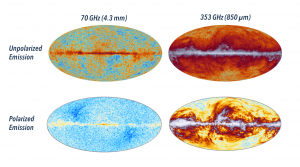
Maps of the intensity of polarized and unpolarized galactic emission at CMB millimeter wavelengths (left) and submillimeter wavelengths (right).
Experiments are currently searching for the imprint of primordial gravitational waves in the polarization of the Cosmic Microwave Background (CMB). If found, this imprint would be the strongest signature to date confirming the paradigm of Cosmological Inflation, in which the universe underwent superluminal expansion during the first fraction of a second after the Big Bang.
The polarized emission from interstellar Galactic dust that BLAST-TNG observes is a major foreground contaminant for observations of the CMB. To separate interstellar dust from the CMB, experiments use submillimeter-wavelength maps where dust is the dominating signal to cross-correlate and subtract the dust from millimeter-wavelengths CMB maps. Current generation CMB experiments are limited in this approach by a lack of high-sensitivity dust maps in the submillimeter, and a limited understanding of the spectral dependence of the polarized dust emission.
BLAST-TNG is poised to make the most sensitive measurements of polarized Galactic dust emission to date. 100 hours of the balloon flight will be dedicated to mapping dust emission in regions of high-galactic latitude overlapping with current-generation state-of-the-art CMB observatories. BLAST-TNG’s ability to resolve small spatial scales will also enable measurements of the effect of dust emission on the CMB lensing spectrum.




